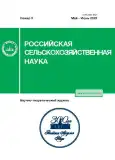The effectiveness of applying various doses of nitrogen fertilizer on spring triticale in the conditions of the Moscow region
- Авторлар: Alenicheva A.D1, Shchukina O.A1
-
Мекемелер:
- Tsytsyn Main Botanic Garden, Russian Academy of Sciences
- Шығарылым: № 3 (2023)
- Беттер: 55-58
- Бөлім: Articles
- URL: https://journals.rcsi.science/2500-2627/article/view/144618
- DOI: https://doi.org/10.31857/S2500262723030109
- EDN: https://elibrary.ru/EZYEXW
- ID: 144618
Дәйексөз келтіру
Толық мәтін
Аннотация
Негізгі сөздер
Авторлар туралы
A. Alenicheva
Tsytsyn Main Botanic Garden, Russian Academy of Sciences
Email: alenicheva_a@mail.ru
127276, Moskva, ul. Botanicheskaya, 4
O. Shchukina
Tsytsyn Main Botanic Garden, Russian Academy of Sciences127276, Moskva, ul. Botanicheskaya, 4
Әдебиет тізімі
- The Effeciency of using nitrogen fertilizers in wheat crop / A. L. Agapie, N. M. Horablaga, C. Bostan, et al. // Life Science and sustanainable development. 2021. Vol. 2. No. 1. URL: https://lssd-journal.com/index.php/lssd/article/view/71 (дата обращения: 17.05.2023). doi: 10.58509/lssd.v2i1.71.
- Завалин А. А. Биологический и минеральный азот в земледелии России, М.: ВНИИА. 2022. 256 с.
- Сорбция аммонийного азота почвами и грунтами различного гранулометрического состава / Р. А. Афанасьев, К. В. Белоусова, В. А. Литвинский и др. // Проблемы агрохимии и экологии. 2016. № 3. С. 26-29.
- Soil nitrogen dynamics and crop residues. A review / C. Baoqing, L. EnKe, T. Qizhuo, et al. // Agronomy for Sustainable Development. 2014. No. 34. С. 429-442.
- The Influence of Plants on the Migration and Transformation of Nitrogen in Plant-Soil Systems: а Review / Z. Bei, C. Liang, J. Song, et al. //Jornal of Soil Science and Plant Nutrition. 2022. No. 22. С. 4084-4102.
- Global nitrogen budgets in cereals: A 50-year assessment formaize, rice, and wheat production systems /j. K. Ladha, A. Tirol-Padre, C. K. Reddy, et al. // Scientic reports. 2016. Vol. 6. No. 1. URL: https://pubmed.ncbi.nlm.nih.gov/26778035/ (дата обращения 17.05.2023). doi: 10.1038/srep19355.
- Вынос элементов питания и окупаемость минеральных удобрений урожаем сортов озимой пшеницы в технология разного уровня интенсивности / Н. Я. Ребух, П. М. Политыков, В. Н. Капранов и др. // Вестник РУДН. Серия: агрономия и животноводство. 2019. Т. 14. № 2. С. 142-153.
- Influence of mineral and organic fertilizerson yield and nitrogen effciency of winter wheat / Š. Buráňová, J. Černý, M. Kulhánek, et al. // International Journal of Plant Production. 2015. Vol. 9. No. 2. С. 257-272.
- Вильдфлуш И. Р., Коготько Е. И. Сортовая отзывчивость яровой пшеницы на условия минерального питания на дерново-подзолистой легкосуглинистой почве // Почвоведение и агрохимия. 2012. № 1. С. 82-89.
- Сандухадзе Б. И., Журавлева Е. В. Азотная подкормка современных интенсивных сортов озимой пшеницы в условиях Центрального Нечерноземья // Питание растений. 2012. № 2. С. 2-6.
- Урожайность, пластичность и стабильность озимого тритикале в условиях Московской области / И. Н. Ворончихина, В. В. Ворончихин, В. С. Рубец и др. // Аграрный научный журнал. 2020. № 12. С. 8-10.
- Грабовец А. И. Проблемы селекции и семеноводства зерновых культур и перспективы научноинновационного обеспечения агропромышленного комплекса регионов // Достижения науки и техники АПК. 2022. Т. 36. № 8. С. 10-13.
- Крохмаль А. В., Грабовец А. И. Показатели адаптивности сортов озимого тритикале в условиях усиления аридности климата на Северо-западе Ростовской области // Вестник Российской сельскохозяйственной науки. 2022. № 3. С. 44-48.
- Абделькави Р. Н.Ф., Соловьев А. А. Особенности формирования качества зерна яровой тритикале в контрастных погодно-климатических условиях // Зерновое хозяйство России. 2020. № 2 (68). С. 3-7.
- Morphophysiological features of the Reaction of the cv. ×Triticosecale Wittm. ex. Camus on Nitrogen Fertilizers in contrasting Agrometeorological Conditions / O. Shchuklina,. A. Alenicheva, I. Klimenkova, et al. // In IOP Conference Series: Earth and Environmental Science. 2022. Vol. 10. URL: https://iopscience.iop.org/article/10.1088/1755-1315/1010/1/012109 (дата обращения: 17.05.2023). doi: 10.1088/1755-1315/1010/1/012109.
- Потребление азота, фосфора и калия растениями различных сортов озимой пшеницы в зависимости от условий минерального питания / О. Ю. Гудиев, Т. Г. Зеленская, А. О. Касаткина и др. // Земледелие. 2019. № 7. С. 24-27.
- Тимирязевская 42 - новый сорт яровой тритикале (×Triticosecale Wittm. ex. Camus) / О. А. Щуклина, А. А. Соловьев, Е. С. Полховская и др. // Кормопроизводство. 2022. № 8. С. 43-46.
- Изучение эффекта генов короткостебельности пшеницы (Triticum aestivum L.) и ржи (Secale cereal L.) на примере расщепляющийся популяции яровой тритикале в условиях вегетационного опыта / П. Ю. Крупин, А. Г. Черноок, Г. И. Карлов и др. // Сельскохозяйственная биология. 2019. Т. 54. № 5. С. 920-933.
- Анализ распределения генов короткостебельности пшеницы и ржи среди сортообразцов яровой гексаплоидной тритикале (Triticosecale Wittm.) / А. Д. Коршунова, М. Г. Дивашук, А. А. Соловьев и др. // Генетика. 2015. Т 51. № 3. С. 334-340.
- Агротехнические и агрохимические аспекты оптимизации азотного питания озимой тритикале на дерново-подзолистой почве Центрального Нечерноземья РФ / В. В. Конончук, С.М., Тимошенко А. М. Медведев и др. //Аграрная Россия. 2022. № 4. С. 7-14.
Қосымша файлдар









